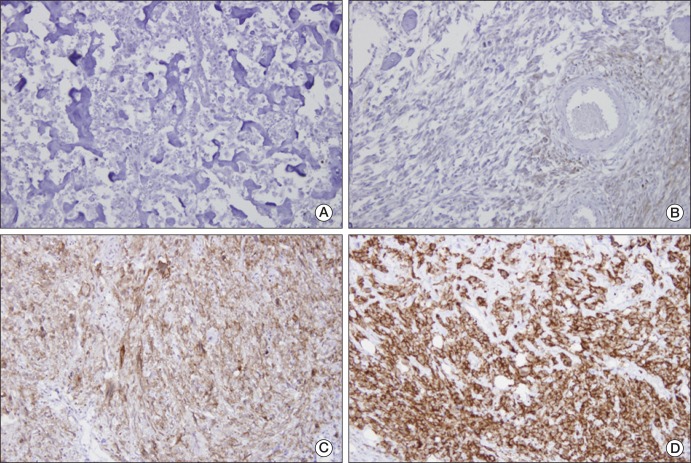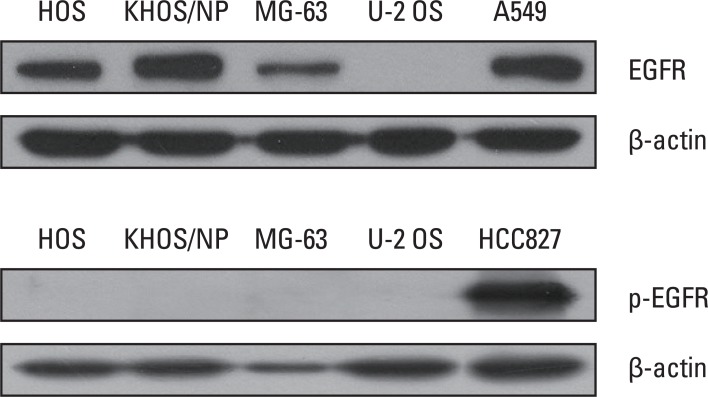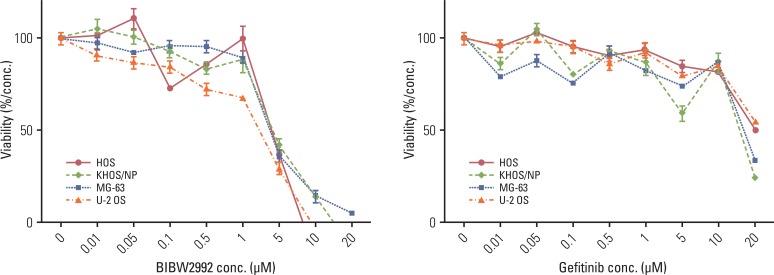Cancer Res Treat.
2012 Sep;44(3):202-209.
Epidermal Growth Factor Receptor: Is It a Feasible Target for the Treatment of Osteosarcoma?
- Affiliations
-
- 1Department of Pediatrics, Korea Cancer Center Hospital, Seoul, Korea.
- 2Department of Orthopedic Surgery, Korea Cancer Center Hospital, Seoul, Korea.
- 3Department of Pathology, Korea Cancer Center Hospital, Seoul, Korea. jskoh@kcch.re.kr
Abstract
- PURPOSE
Features of epidermal growth factor receptor (EGFR) expression in osteosarcoma and in vitro efficacies of EGFR inhibitors against osteosarcoma cells were evaluated.
MATERIALS AND METHODS
Thirty biopsy samples of osteosarcoma patients were retrospectively analyzed for EGFR protein expression by immunohistochemistry. Relationships between EGFR expression and clinicopathologic characteristics and treatment outcomes were evaluated. Four osteosarcoma cell lines were analyzed for EGFR and p-EGFR expression by western blotting. Efficacies of gefitinib and BIBW2992 on osteosarcoma cells were evaluated using a 3-(4,5-dimethylthiazol-2-yl)-2,5-diphenyltetrazolium bromide assay. Tyrosine kinase domains in exons 18 to 21 were sequenced and gene expression analyses of EGFR and PTEN were performed in four osteosarcoma cell lines.
RESULTS
EGFR protein was expressed in 27 (90%) samples (6 low, 12 intermediate, 9 high) and in three cell lines. Intermediate or high staining for EGFR was related to a tumor volume<150 mL (p<0.001) and histologic subtype other than osteoblastic type (p=0.03). However, EGFR expression was not associated with histologic response to preoperative chemotherapy or survival. Gefitinib and BIBW 2992 did not have any significant inhibitory effect on cell viabilities. DNA sequencing analysis revealed three osteosarcoma cell lines have single base changes at codon 2361 of exon 20 (G to A), without affecting translation results. Furthermore, no mutation was found to be associated with constitutive EGFR activation.
CONCLUSION
In the present study, gefitinib and BIBW2992 were not effective against osteosarcoma cells. However, as osteosarcoma cells express EGFR, further studies are necessary to explore the potential of other therapeutic agents targeting EGFR.
MeSH Terms
-
Biopsy
Blotting, Western
Cell Line
Cell Survival
Codon
Epidermal Growth Factor
Exons
Gene Expression
Humans
Immunohistochemistry
Osteoblasts
Osteosarcoma
Protein-Tyrosine Kinases
Quinazolines
Receptor, Epidermal Growth Factor
Retrospective Studies
Sequence Analysis, DNA
Tetrazolium Salts
Thiazoles
Codon
Epidermal Growth Factor
Protein-Tyrosine Kinases
Quinazolines
Receptor, Epidermal Growth Factor
Tetrazolium Salts
Thiazoles
Figure
Reference
-
1. Bacci G, Longhi A, Fagioli F, Briccoli A, Versari M, Picci P. Adjuvant and neoadjuvant chemotherapy for osteosarcoma of the extremities: 27 year experience at Rizzoli Institute, Italy. Eur J Cancer. 2005; 41:2836–2845. PMID: 16298125.
Article2. Gorlick R, Anderson P, Andrulis I, Arndt C, Beardsley GP, Bernstein M, et al. Biology of childhood osteogenic sarcoma and potential targets for therapeutic development: meeting summary. Clin Cancer Res. 2003; 9:5442–5453. PMID: 14654523.3. Bacci G, Forni C, Ferrari S, Longhi A, Bertoni F, Mercuri M, et al. Neoadjuvant chemotherapy for osteosarcoma of the extremity: intensification of preoperative treatment does not increase the rate of good histologic response to the primary tumor or improve the final outcome. J Pediatr Hematol Oncol. 2003; 25:845–853. PMID: 14608193.4. Eselgrim M, Grunert H, Kuhne T, Zoubek A, Kevric M, Burger H, et al. Dose intensity of chemotherapy for osteosarcoma and outcome in the Cooperative Osteosarcoma Study Group (COSS) trials. Pediatr Blood Cancer. 2006; 47:42–50. PMID: 16206218.
Article5. Kager L, Zoubek A, Potschger U, Kastner U, Flege S, Kempf-Bielack B, et al. Primary metastatic osteosarcoma: presentation and outcome of patients treated on neoadjuvant Cooperative Osteosarcoma Study Group protocols. J Clin Oncol. 2003; 21:2011–2018. PMID: 12743156.
Article6. Meyers PA, Gorlick R, Heller G, Casper E, Lane J, Huvos AG, et al. Intensification of preoperative chemotherapy for osteogenic sarcoma: results of the Memorial Sloan-Kettering (T12) protocol. J Clin Oncol. 1998; 16:2452–2458. PMID: 9667263.
Article7. Herbst RS, Kies MS. ZD1839 (Iressa) in non-small cell lung cancer. Oncologist. 2002; 7(Suppl 4):9–15. PMID: 12202783.
Article8. Raben D, Helfrich BA, Chan D, Johnson G, Bunn PA Jr. ZD1839, a selective epidermal growth factor receptor tyrosine kinase inhibitor, alone and in combination with radiation and chemotherapy as a new therapeutic strategy in non-small cell lung cancer. Semin Oncol. 2002; 29(1 Suppl 4):37–46. PMID: 11894012.
Article9. Vivanco I, Mellinghoff IK. Epidermal growth factor receptor inhibitors in oncology. Curr Opin Oncol. 2010; 22:573–578. PMID: 20739887.
Article10. Yarom N, Jonker DJ. The role of the epidermal growth factor receptor in the mechanism and treatment of colorectal cancer. Discov Med. 2011; 11:95–105. PMID: 21356164.11. Sharafinski ME, Ferris RL, Ferrone S, Grandis JR. Epidermal growth factor receptor targeted therapy of squamous cell carcinoma of the head and neck. Head Neck. 2010; 32:1412–1421. PMID: 20848399.
Article12. Dobashi Y, Suzuki S, Sugawara H, Ooi A. Involvement of epidermal growth factor receptor and downstream molecules in bone and soft tissue tumors. Hum Pathol. 2007; 38:914–925. PMID: 17376509.
Article13. Dobashi Y, Takei N, Suzuki S, Yoneyama H, Hanawa M, Ooi A. Aberration of epidermal growth factor receptor expression in bone and soft-tissue tumors: protein overexpression, gene amplification and activation of downstream molecules. Mod Pathol. 2004; 17:1497–1505. PMID: 15254554.
Article14. Oda Y, Wehrmann B, Radig K, Walter H, Rose I, Neumann W, et al. Expression of growth factors and their receptors in human osteosarcomas Immunohistochemical detection of epidermal growth factor, platelet-derived growth factor and their receptors: its correlation with proliferating activities and p53 expression. Gen Diagn Pathol. 1995; 141:97–103. PMID: 8548600.15. Do SI, Jung WW, Kim HS, Park YK. The expression of epidermal growth factor receptor and its downstream signaling molecules in osteosarcoma. Int J Oncol. 2009; 34:797–803. PMID: 19212684.
Article16. Freeman SS, Allen SW, Ganti R, Wu J, Ma J, Su X, et al. Copy number gains in EGFR and copy number losses in PTEN are common events in osteosarcoma tumors. Cancer. 2008; 113:1453–1461. PMID: 18704985.17. Wen YH, Koeppen H, Garcia R, Chiriboga L, Tarlow BD, Peters BA, et al. Epidermal growth factor receptor in osteosarcoma: expression and mutational analysis. Hum Pathol. 2007; 38:1184–1191. PMID: 17509661.
Article18. Kersting C, Gebert C, Agelopoulos K, Schmidt H, van Diest PJ, Juergens H, et al. Epidermal growth factor receptor expression in high-grade osteosarcomas is associated with a good clinical outcome. Clin Cancer Res. 2007; 13:2998–3005. PMID: 17505002.
Article19. Lee JA, Kim MS, Kim DH, Lim JS, Yoo JY, Koh JS, et al. Relative tumor burden predicts metastasis-free survival in pediatric osteosarcoma. Pediatr Blood Cancer. 2008; 50:195–200. PMID: 18061933.
Article20. Batus M, Fidler MJ, Bonomi PD. Primary and secondary therapeutic strategies for EGF receptor pathway inhibition in non-small-cell lung cancer. Expert Rev Anticancer Ther. 2010; 10:1589–1599. PMID: 20942630.
Article21. Hughes DP, Thomas DG, Giordano TJ, McDonagh KT, Baker LH. Essential erbB family phosphorylation in osteosarcoma as a target for CI-1033 inhibition. Pediatr Blood Cancer. 2006; 46:614–623. PMID: 16007579.
Article22. Stewart CF, Leggas M, Schuetz JD, Panetta JC, Cheshire PJ, Peterson J, et al. Gefitinib enhances the antitumor activity and oral bioavailability of irinotecan in mice. Cancer Res. 2004; 64:7491–7499. PMID: 15492275.
Article23. Sirotnak FM, Zakowski MF, Miller VA, Scher HI, Kris MG. Efficacy of cytotoxic agents against human tumor xenografts is markedly enhanced by coadministration of ZD1839 (Iressa), an inhibitor of EGFR tyrosine kinase. Clin Cancer Res. 2000; 6:4885–4892. PMID: 11156248.
- Full Text Links
- Actions
-
Cited
- CITED
-
- Close
- Share
- Similar articles
-
- Amplification of epidermal growth factor receptor gene in primary cervical cancer
- Amplification of epidermal growth factor receptor gene in primary cervical cancer
- Epidermal growth factor receptors increase in rabbit embryonal implantation
- Correlation of epidermal growth factor receptor expression with prognostic factors in patients with ovarian neoplasms
- Prognostic significance of epidermal growth factor receptor expression in human gastric carcinoma





